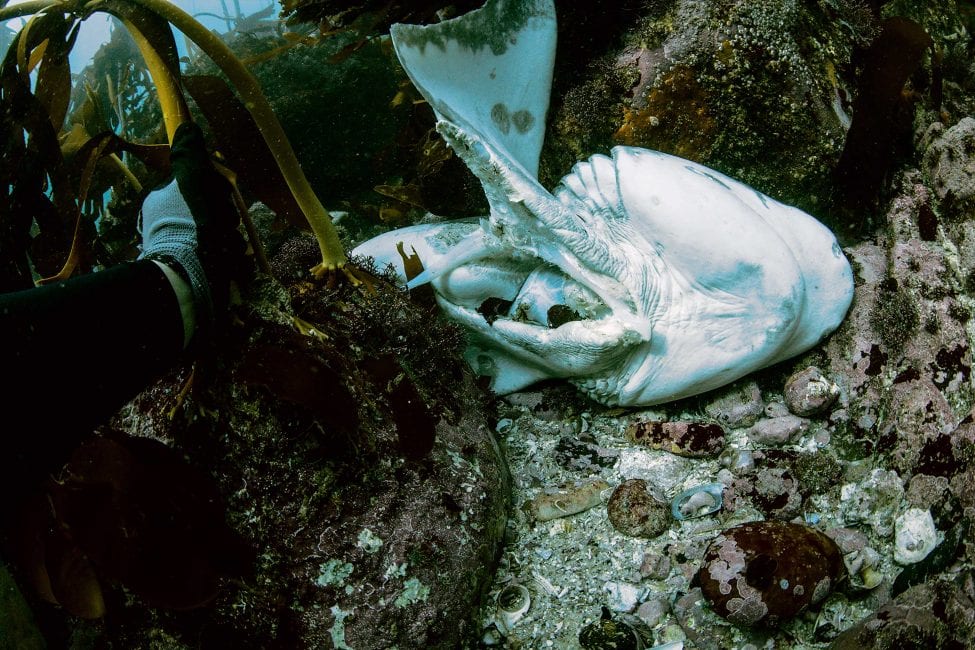Running scared: when predators become prey
Along the south-western coast of South Africa, the terms Port and Starboard have gained a new meaning. No longer just shipboard directions, they refer to a pair of black-and-white predators that are changing the marine landscape of False Bay and its environs.
It seems that False Bay is one of those places that will never cease to surprise, particularly with regard to the dynamics among its top predators. The area hosts not one, but two of the largest known aggregations of sharks globally. Of course, the presence of white sharks Carcharodon carcharias is one of False Bay’s most prominent claims to fame and the sharks’ aerial antics at Seal Island keep tourists coming annually from all over the world. However, along the western border of the bay there is another, lesser-known aggregation. Nestled in a sheltered cove where kelp forests and sandy channels are interspersed, Miller’s Point is home to a unique aggregation of broadnose sevengill sharks Notorynchus cepedianus. Although these docile kelp-dwellers clock in at half the maximum size of white sharks and more closely resemble animated oven mitts than lethal predators, studies have shown that they feed on many of the same prey species as white sharks and hence have an equally important role in the coastal ecosystems they inhabit.
When I began my PhD in 2015, one of my primary aims was to improve our current understanding of the role that sevengills play as a predator in False Bay. Miller’s Point provided a fascinating and unique study site as well as a scuba diving hotspot, where it is possible to get up close and personal with as many as 70 broadnose sevengill sharks in a single hour’s dive. The primary reason for sevengills aggregating at this particular spot is thought to be as a refuge; however high up the food chain these sharks technically are, they would rather avoid direct confrontation with a species double their size. White sharks are known to shun dense kelp forests, so the sevengills had found the perfect spot to cool their heels during the day before venturing out to hunt at night, when the chance of running into a white shark was greatly reduced. And so the dynamic between these two predators was maintained, with each playing its respective role at the top end of the food chain.
However, a spanner was unexpectedly thrown into the works when a new predator arrived in the waters of False Bay: the killer whale Orcinus orca. This super predator has historically been incredibly rare in this area, with only a handful of sightings over the past century. However, since 2009 there has been a steady increase in its presence in False Bay. Initially, there appeared to be little impact on the shark species in the bay and the killer whales were only ever observed feeding on marine mammals such as dolphins and seals. A fascinating characteristic of the species is its incredible dietary specialisation and prey selectivity. Although globally it is known to prey on more than 120 species, different pods have been shown to specialise on a key prey type or species, adapting specialist hunting tactics tailored to capturing their chosen prey. This specialisation has led to divergence among pods, even those that have sympatric ranges, resulting in differences in social structure, behaviour, communication and even morphology. Therefore, despite the current classification of killer whales as a single species, there are a number of different subgroups or ‘ecotypes’ that exist globally. In False Bay, it appeared that the pods that had been observed were a ‘mammal specialist’ ecotype, so their sporadic presence had little effect on either white sharks or sevengills.
The Shark Spotters
The Shark Spotters programme in Cape Town, South Africa, improves beach safety through both shark warnings and emergency assistance in the event of a shark incident. The programme contributes to research on shark ecology and behaviour, raises public awareness about shark-related issues, and provides employment opportunities and skills development for spotters.
